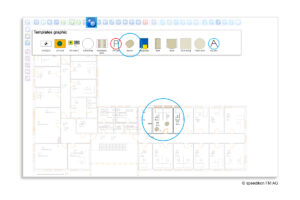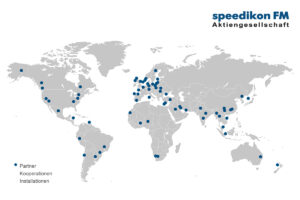What is the best software for CAFM? This is by far the most popular question on the market, and it is practically always wrong. Why is that? The answer is simple: something is missing.
The ‘something’ that is missing is either
- the intended use,
- the environment of use,
- existing software,
- the phrase ‘for me’.
Because one thing is certain from the outset: a CAFM system is always an individual solution that may be more or less standardised. Here, too, the question needs to be asked: To what standard exactly?
The internet as a cabinet of curiosities
The first place to go to gain more clarity is probably the internet, and for some, the classic search engine. Thanks to the search engine optimisation of various websites, there are also plenty of answers. There are manufacturers who set up a ranking in which they actually come off as the best, while systems that are not comparable anyway are not quite as convincing. There are evaluation portals that specialise in everything and have therefore found a place for CAFM applications alongside kitchen machines and living room sofas. And there are experts who take pleasure in publicising their limited knowledge with bias. Although this is interesting to look at, it is not helpful.
ChatGPT knows its stuff?
The alternative is to ask ChatGPT or another AI bot. The answers are as colourful as the rainbow. This is because ChatGPT does what chatbots do best – babble haphazardly.
In addition, such a bot usually remembers what has already been asked and favoured as an answer, because the next prompt is based on this. This is promptly followed by an output with – you guessed it – its own bias. At least you are more involved in the result. However, it is unlikely to help, because if you work with different inputs, you will get different outputs. A test I carried out for
- ‘Which is the best CAFM system?’ resulted in four suggestions, one of which was actually a CAFM system, interestingly with “CAFM” and ‘System’ in the company name. The results also included a GIS software, a CMMS and a workplace software. Apparently, IWMS and CAFM seem to be understood synonymously pars pro toto, in other words. Unfortunately, this is wrong.
- ‘Which is the best CAFM software?’ led to eleven results, the first six of which are actually CAFM applications. Their manufacturers do a lot of marketing, have a corresponding presence in the market, and the top three results not only show a focus on the US market, but also on the Verdantix Green Quadrant, which evaluates the field of those willing to pay for software as a purchase test for a fee of several thousand US dollars. Incidentally, the results of the tables range from ‘good’ to ‘leading’ – who would be rude to their well paying customers?
So what to do?
This reveals a core dilemma: there are no neutral assessments. And the main reason for this is that – as mentioned above – something is missing: namely the specific use case in its specific IT and working environment. And this use case is fundamentally a distinct individual that, despite some similarities to other use cases, will nevertheless have many peculiarities that must be taken into account in the evaluation.
Therefore, a lot of basic research and manual work is required to find out which CAFM software would actually be the best. The key points are:
- Prerequisites and expectations: Firstly, it makes sense to check your own requirements. What exactly do I want to do with a CAFM solution and what exactly do I want to achieve with it? This does not mean a specification sheet, but rather a comprehensive brainstorming session, the result of which serves as a cross-off list so that the first draft does not immediately overwhelm you.
- Sift through the market: Once it is clear which areas of FM are to be supported by software, the next step would be to consult the ‘GEFMA 940 CAFM Software Market Overview’ if you are searching in the G-A-S market. It is updated annually and lists around 30 manufacturers of corresponding solutions, as well as consultants and integrators. Although the information provided by the manufacturers is not editorially checked, it is usually reliable. The basic parameters of all solutions are summarised in a matrix. If you use a pen to mark all the columns whose modules correspond to your own requirements, you can easily find out which applications fulfil all your own requirements.
- Recognise specialists: Many providers of CAFM applications originally started with other software products, from which their solutions for facility management have developed over time. This can still be seen in some software products today, but this should not be taken negatively. Specialised knowledge, for example in network topologies, energy management or the hospital environment, is of particular value to certain customer groups.
- Industry knowledge: The situation is similar with industry specialisations. Here too, manufacturers cannot hide their history, and they don’t have to. After all, being particularly well versed in an environment is a trump card in the hands of both the provider and the customer if the latter comes from that or a related industry. After all, the offer then also includes a comprehensive level of industry expertise, which should be reflected in a significantly faster customisation and introduction of the solution.
- Ensure selection: It is advisable to look at the manufacturer’s reference customers. On the one hand, this makes it possible to determine the market segments in which the respective providers are already active and therefore have experience. On the other hand, the selection of customers can be an indicator of how well the solution suits you – a rural municipality will be less likely to be in good hands with a provider with internationally active industrial companies, and a car manufacturer will hardly be in good hands with a software company that specialises in area and cleaning management. The GEFMA 444 certification, which is sometimes used as an indicator, can sometimes help. The seal would ensure that basic functionalities are in place and that the application works reliably. However, the GEFMA auditors do not check the depth of the systems where the actually important performance features work.
- Good advice makes sense: It always makes sense to bring a consultant on board. The objection that such a specialist costs extra may be formally correct, but in most cases their experience and expertise saves significantly more than the consultancy costs. CAFM implementation only seems simple at first glance. On closer inspection, future users will find themselves on the high seas for a year. And often in heavy weather. This is because desire and feasibility, internal competence disputes and various other aspects can quickly become a lasting stumbling block without external expertise and neutral moderation and, in the worst case, cause a CAFM introduction to fail completely. However, it is important to ensure that the consultant does not have a favorite software that he prefers to introduce or that certain applications are not included as a matter of principle.
- Competence in the software company: It is also important that the software provider offers professional consulting services. This is particularly necessary in the implementation phase and pays off very quickly, because the experienced consultants know the potential of your application and can therefore very quickly and reliably point out solutions and then implement them successfully.
It’s worth the effort
Anyone who wants to introduce CAFM software quickly is usually served the old truth: If you want to make it easy, it’s difficult. Facility management software, like any other software, is complex. Selecting the right software requires comprehensive knowledge of your own company and your own requirements. Integrating it into existing systems requires extensive expertise. And using it requires a system that is customised to the respective user, which is summed up in the term ‘high usability’.
It is therefore worth investing a little more time and money in the initial steps. Bluntly spoken the time is needed to compare your own wishes with your own capabilities within the company. The money is needed to level the path at the beginning, which will save money in the long term and sustainably later on. After all, this is one, if not the main reason for equipping the company’s facility management with professional software: to generate savings.
Image: Freepik; Montage: speedikon FM AG




